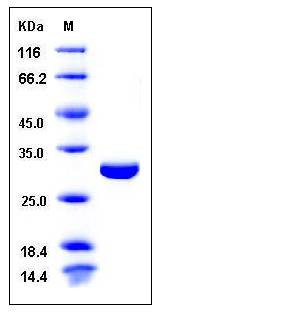Human CLIC4 Protein (His Tag)
CLIC4L,H1,huH1,MTCLIC,p64H1
- 100ug (NPP3744) Please inquiry
| Catalog Number | P12271-H07E |
|---|---|
| Organism Species | Human |
| Host | E. coli |
| Synonyms | CLIC4L,H1,huH1,MTCLIC,p64H1 |
| Molecular Weight | The recombinant human CLIC4 consisting of 263 amino acids and migrates as an 30 kDa band in SDS-PAGE under reducing conditions as predicted. |
| predicted N | Met |
| SDS-PAGE |  |
| Purity | > 97 % as determined by SDS-PAGE |
| Protein Construction | A DNA sequence encoding the human CLIC4 (Q9Y696-1) (Ala 2-Lys 253) was expressed, with a polyhistide tag at the N-terminus. |
| Bio-activity | |
| Research Area | Developmental Biology |Metabolism |Plasma Membrane |Channels |
| Formulation | Lyophilized from sterile PBS, pH 7.4 1. Normally 5 % - 8 % trehalose, mannitol and 0.01% Tween80 are added as protectants before lyophilization. Specific concentrations are included in the hardcopy of COA. |
| Background | Chloride intracellular channel protein 4, also known as Intracellular chloride ion channel protein p64H1 and CLIC4, is a member of the chloride channel CLIC family. It contains one GST C-terminal domain. CLIC4 is a member of a family of intracellular chloride channels. It is regulated by p53, c-Myc, and tumor necrosis factor-alpha. CLIC4 is detected in epithelial cells from colon, esophagus and kidney (at protein level). CLIC4 has alternate cellular functions like a potential role in angiogenesis or in maintaining apical-basolateral membrane polarity during mitosis and cytokinesis. CLIC4 could promote endothelial cell proliferation and regulate endothelial morphogenesis (tubulogenesis). Expression of CLIC4 is prominent in heart, kidney, placenta and skeletal muscle. Overexpression of CLIC4 in cancer cells inhibits tumor growth. Conversely, overexpression of CLIC4 in tumor stromal cells stimulates tumor growth. Thus, CLIC4 participates in normal and pathological processes and may serve as a useful target for therapies in disturbances of homeostasis and neoplastic transformation. Loss of CLIC4 in tumor cells and gain in tumor stroma is common to many human cancers and marks malignant progression. Up-regulation of CLIC4 in tumor stroma is coincident with myofibroblast conversion, generally a poor prognostic indicator. Reactivation and restoration of CLIC4 in tumor cells or the converse in tumor stromal cells could provide a novel approach to inhibit tumor growth. |
| Reference |
